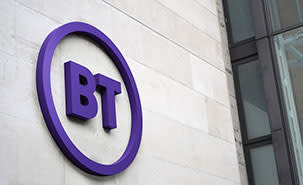BT Group reported full-year underlying revenue up 2 % to £20.8bn, supported by strong performance in Openreach and Consumer. This was offset by challenges in the Business unit, which had its value written down by £0.5bn. Underlying cash profit (EBITDA) rose 1% to £8.1bn.
Underlying free cash flow fell 4% to £1.3bn, with the timing of payments and a prior year tax refund contributing to the decline. Net debt, including leases, rose £0.6bn to £19.5bn driven by pension scheme contributions.
For the coming year, BT expects adjusted revenue growth of 0-1%, cash profit of around £8.2bn, and underlying free cash flow of approximately £1.5bn (prior consensus £1.3bn).
The board declared a final dividend of 5.69p, bringing the full-year dividend to 8.00p, up 3.9%.
The shares rose 8.2% in early trading.
Our view
Full-year results for BT were ok, nothing to shoot the lights out. Where markets got excited is over the free cash flow guide, which was a good chunk ahead of expectations.
Cost cuts remain in focus, led by the news that the existing plan completed ahead of schedule and another £3bn of annual savings are expected to be delivered over the next few years. There’s also news that the cost of building fibre and 5G infrastructure may have peaked. That’s good news for future cash flow, and the valuation which it’s weighed on for some time. Once the infrastructure is built and adopted, a much leaner operation is needed to generate long-term growth.
The wider strategy involves significantly modernising and simplifying operations and product lines. This includes switching all mobile products under the EE brand and moving customers onto the new 5G and fibre broadband networks, which have lower running costs than legacy infrastructure.
The asset we’re most excited by is Openreach, which is responsible for maintaining and building out the new fibre networks. It hopes to reach 25mn premises by 2026 and looks well on track to do that. This technical-heavy business is unique and higher margin.
The Business division continues to be the problem child - so much so that BT had to write down the value of the asset to the tune of nearly £500mn. A combination of structural changes, higher costs, and a tough competitive landscape are making it a tricky place to operate. It’s still throwing off free cash, but at margins that are good clip lower than those of the Consumer and Openreach units.
Another drain on cash is BT's large pension deficit. The current payment plan cost just over £800mn in the year just ended. Add to that the debt and lease pile, which cost a combined £1.6bn to service over the half, and the drags on cash are hefty.
BT’s future relies heavily on getting past the peak buildout phase, and to its credit, progress looks good. We think BT is one of the better-placed names, especially with a great asset like Openreach on the books. The question yet to be answered is whether all that spending is going to generate enough top-line growth to materially offset the decline of legacy products, a challenge for the entire sector to battle with.
BT key facts
All ratios are sourced from Refinitiv, based on previous day’s closing values. Please remember yields are variable and not a reliable indicator of future income. Keep in mind key figures shouldn’t be looked at on their own – it’s important to understand the big picture.
This article is not advice or a recommendation to buy, sell or hold any investment.No view is given on the present or future value or price of any investment, and investors should form their own view on any proposed investment.This article has not been prepared in accordance with legal requirements designed to promote the independence of investment research and is considered a marketing communication.Non - independent research is not subject to FCA rules prohibiting dealing ahead of research, however HL has put controls in place(including dealing restrictions, physical and information barriers) to manage potential conflicts of interest presented by such dealing.Please see our full non - independent research disclosure for more information.


